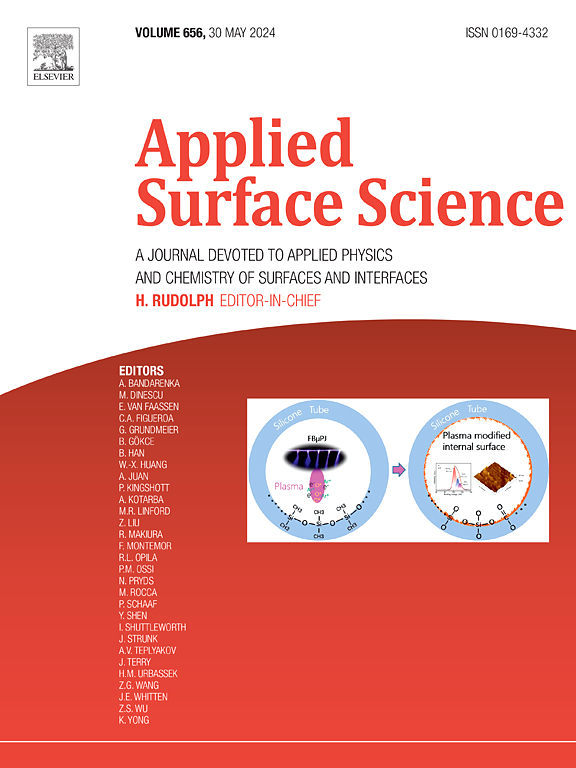催化剂对氮化镓纳米材料电子性能的影响
IF 6.3
2区 材料科学
Q2 CHEMISTRY, PHYSICAL
引用次数: 0
摘要
目前,氮化镓纳米材料(GaN- nms)的形态状态裁剪研究进展备受关注。然而,在合成过程中使用不同类型的催化剂可能会改变GaN-NMs的电子响应结果。在此,我们证明了元素和表面敏感x射线吸收光谱(XAS)作为区分由Ge, Ni和Ge/Ni催化剂合成的GaN-NMs的Ga L-和N k -边缘特征的工具的适用性。特别是,我们解决了间接调谐N原子的未占据2p态的含义,对应于在低温下进行轨道杂化混合。我们提出催化剂的类型在确定N轨道的sp3sp3/sp2sp2比率中起作用,正如XAS光谱的反褶积所观察到的那样。温度相关的XAS表明,在达到80 K的拐点之前,sp2sp2对Ni和ge催化的GaN-NMs的贡献最大。另一方面,Ge/Ni催化的GaN-NMs的sp3sp3贡献呈分钟增加趋势。我们提出可以通过XRD和XAS位移实现结构-性质的关联,从而提出了杂化电子态相互转换轨道排列的简化模型。为了研究基于不同形状纳米材料的光电应用,电流电压测量显示,Ge/ ni催化的GaN-NMs由于其最大的表面积而表现出最佳的光电响应。这项工作提供了通过形貌控制来剪裁GaN-NMs电子特性的理解。本文章由计算机程序翻译,如有差异,请以英文原文为准。


Influence of catalysts on the electronic properties of gallium nitride nanomaterials
The current advancement in tailoring the morphological states of GaN nanomaterials (GaN-NMs) is highly pursued. However, utilising different types of catalysts during the synthesis could alter the outcome of the electronic response of the GaN-NMs. Herein, we demonstrate the applicability of the element- and surface-sensitive X-ray absorption spectroscopy (XAS) as a tool to distinguish Ga L- and N K-edges features of GaN-NMs synthesised with Ge, Ni, and Ge/Ni catalysts. In particular, we resolved the implication of tuning indirectly the unoccupied 2p states of N atoms corresponding to access the orbital hybridisation mixing at low temperatures. We propose that the type of catalysts play a role in determining the / ratio of N orbitals, as observed with a deconvolution of XAS spectra. Temperature-dependent XAS exemplified the hold majority contribution for Ni- and Ge-catalysed GaN-NMs until reaching the inflexion point at 80 K. On the other hand, Ge/Ni catalysed GaN-NMs display a minute-increasing trend of contribution. We propose that the structure–property correlation can be realised from the XRD and XAS shifts, thus a simplified model of interconversion orbital arrangement of hybrid electronic states is proposed. To investigate the applications for optoelectronic applications based on the different shapes of the nanomaterials, current–voltage measurement reveals that Ge/Ni-catalysed GaN-NMs shows the best photoelectric response as credited to their largest surface area. This work provides an understanding of tailoring the electronic properties of GaN-NMs by morphology control.
求助全文
通过发布文献求助,成功后即可免费获取论文全文。
去求助
来源期刊

Applied Surface Science
工程技术-材料科学:膜
CiteScore
12.50
自引率
7.50%
发文量
3393
审稿时长
67 days
期刊介绍:
Applied Surface Science covers topics contributing to a better understanding of surfaces, interfaces, nanostructures and their applications. The journal is concerned with scientific research on the atomic and molecular level of material properties determined with specific surface analytical techniques and/or computational methods, as well as the processing of such structures.
 求助内容:
求助内容: 应助结果提醒方式:
应助结果提醒方式:


